2017年上半年中小学教师资格考试英语学科知识与教学能力试题及答案解析(初级中学)
- 格式:pdf
- 大小:157.83 KB
- 文档页数:19
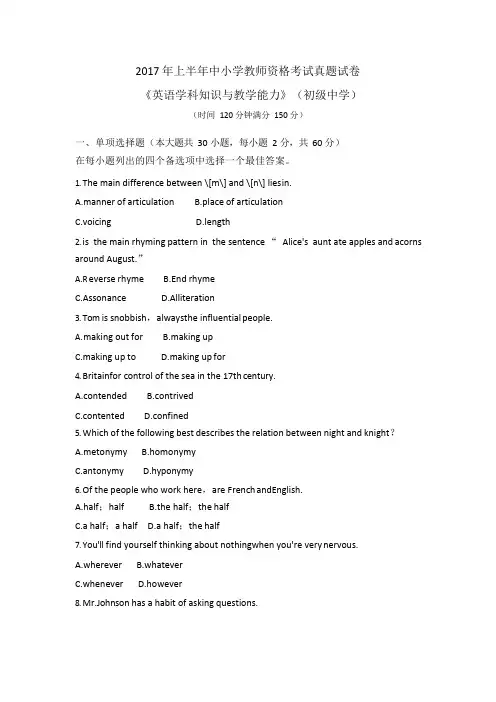
2017 年上半年中小学教师资格考试真题试卷《英语学科知识与教学能力》(初级中学)(时间120 分钟满分150 分)一、单项选择题(本大题共30 小题,每小题2 分,共60 分)在每小题列出的四个备选项中选择一个最佳答案。
1.The main difference between \[m\] and \[n\] lies i n.A.manner of articulationB.place of articulationC.voicingD.length2.is the main rhyming pattern in the sentence “ Alice's aunt ate apples and acorns around August.”A.R everse rhymeB.End rhymeC.AssonanceD.Alliteration3.Tom is snobbish,alwaysthe influential people.A.m aking out forB.making upC.making up toD.making up for4.Britainfor control of the sea in the 17th century.A.contendedB.contrivedC.contentedD.confined5.Which of the following best describes the relation between night and knight?A.metonymyB.homonymyC.antonymyD.hyponymy6.Of the people who work here,are French andEnglish.A.half;halfB.the half;the halfC.a half;a halfD.a half;the half7.You'll find yourself thinking about nothingwhen you're very n ervous.A.whereverB.whateverC.wheneverD.however8.Mr.Johnson has a habit of asking questions.A.a nd then not listen to the answersB.but then not listen to the answersC.and then not listening to the answersD.and then doesn't listen to the a nswers9.On hearing the utterance“It's hot here”,the listener opened the door.It is a(n).A.l ocutionary actB.illocutionary actC.direct speech actD.perlocutionary act10.What rhetoric device is used in the sentence“Many hands make light work”?A.S ynecdoche.B.Simile.C.Metaphor.D.Oxymoron.11.When the teacher attempts to elicit more information from the students by saying “And…”,“Good,anything else?”,etc.,he/she is playing the role of a.A.prompterB.participantC.managerD.consultant12.For more advanced learners,group work may be more appropriate than pair work for tasks that are.A.linguistically simpleB.structurally controlledC.cognitively challengingD.thematically non demanding13.When you focus on “utterance function ”and “expected response ”b y using examples like“Here you are”,“Thanks”,you are probably teaching language at the.A.lexical levelB.sentence levelC.grammatical levelD.discourse level14.Which of the following tasks fails to encourage active language use?A.Reciting a text.B.Bargaining in a shop.C.Writing an application letter.D.Reading to get a message.15.A teacher may encourage students towhen they come across new words in fast reading.A.take notesB.ask for helpC.guess meaning from contextD.look up the words in a dictionary16.Which of the following statements about task design is incorrect?A.Activities must have clear and attainable o bjectives.B.Activities should be confined to the classroom context.C.Activities must be relevant to students' life experiences.D.Activities should help develop students' language ability.17.When someone says “I know the word ”,he should not only understand its meaning but also be able to pronounce,spell andit.A.explainB.recognizeC.memorizee18.Teachers could encourage students to useto gather and organize their ideas for writing.A.elicitingB.mind mappingC.explainingD.brainstorming19.When students are asked to go to the local museum ,libraries ,etc.to find out information about endangered animals and work out a plan for an exhibition,they are doing a(n).A.surveyB.experimentC.projectD.presentation20.Which of the following tasks fails to develop students' skill of recognizing discourse patterns?A.Analyzing the structure of difficult sentences.B.Checking the logic of the author's arguments.C.Getting the scrambled sentences into a paragraph.D.Marking out common openers to stories and jokes.题答要不内线订装线订装线订装题答要不内线订装请阅读Passage 1,完成21~25 小题。
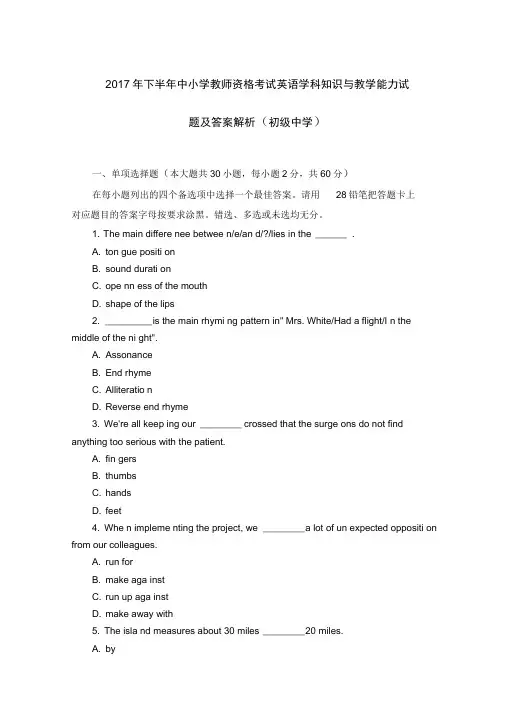
2017年下半年中小学教师资格考试英语学科知识与教学能力试题及答案解析(初级中学)一、单项选择题(本大题共30小题,每小题2分,共60分)在每小题列出的四个备选项中选择一个最佳答案。
请用28铅笔把答题卡上对应题目的答案字母按要求涂黑。
错选、多选或未选均无分。
1. The main differe nee betwee n/e/an d/?/lies in the ______ .A. ton gue positi onB. sound durati onC. ope nn ess of the mouthD. shape of the lips2. _________ i s the main rhymi ng pattern in" Mrs. White/Had a flight/I n the middle of the ni ght".A. AssonanceB. End rhymeC. Alliteratio nD. Reverse end rhyme3. We're all keep ing our ________ crossed that the surge ons do not find anything too serious with the patient.A. fin gersB. thumbsC. handsD. feet4. Whe n impleme nting the project, we ________ a lot of un expected oppositi on from our colleagues.A. run forB. make aga instC. run up aga instD. make away with5. The isla nd measures about 30 miles ________ 20 miles.A. byB. withC. toD. upon6. --Will John come to the party?--No, he won't come and _________ .A. Antony n either won' tB. won' t Antony n eitherC. either will An to nyD. n either will Antony7. Garbo plays the role of the queen, _______ in the love she has found withAn to nio.A. rejoicedB. rejoici ngC. being rejoicedD. to rejoice8. ________ m i nisters decide to in stigate an inquiry, we welcome it.A. Should ... wouldB. Suppose ... couldC. If... wouldD. Would ... will9. What is miss ing at the discourse level betwee n the two sen ten ces "Carol loves tomatoes. She was born in Africa."?A. Refere nee.B. Cohesi on.C. Cohere nee.D. Substituti on.10. The synonyms "charge" and "accuse" mai nly differ in _______ .A. emotio nB. dialectC. formalityD. collocati on11. Which of the following instructions is helpful in developing students' ability to make inferen ces?A. Liste n to a story and write a summary.B. Liste n to a story and work out the writer' s in ten tio n.C. Liste n to the story of a boy and the n draw a picture of him.D. Liste n to a story and note dow n the specific date of an eve nt.12. The most suitable questi on type to check stude nts' comprehe nsion and develop their critical thi nking is ________ .A. rhetorical questio nsB. refere ntial questio nsC. close questi onsD. display questio ns13. Diag no stic test is ofte n used for the purpose ofA. finding out what stude nts know and don' t knowB. measuri ng stude nts' gen eral la nguage proficie ncyC. knowing whether stude nts have the right Ian guage aptitudeD. check ing whether stude nts have achieved the teach ing objectives14. Which of the following activities is often used to develop students' speaking accuracy?A. Ide ntify ing and correct ing oral mistakes.B. Act ing out the dialogue in the text.C. Having discussi ons in groups.D. Describ ing people in pair.15. If a teacher asks students to make their own leanning plan, he/she is trying to develop their ________ .A. cog nitive strategyB. affective strategyC. com muni cative strategyD. metacog nitive strategy16. When a teacher tells students that the word "dog" may imply "loyalty", he/she is teach ing the ________ o f the word.A. deno tative meaningB. cono cative meaningC. con ceptual meaningD. conno tative meaning17. Which of the following is the last step in the process of writing essays?A. Edit ing the writ in gs.B. Writ ing topic senten ces for paragraphs.C. Gatheri ng in formatio n and ideas releva nt to the topic.D. Orga nizing the in formati on and ideas into a logical seque nee.18. The main purpose of ask ing questi ons about the topic before liste ning is toA. meet stude nts' expectati onB. i ncrease stude nts' con fide neeC. activate stude nts' schemataD. provide feedback on tasks19. Ifa teacher asks stude nts to fill in the bla nks in a passage with "that", "which" or "whom",he/she is least likely focus ing on grammar at _______ .A. lexical levelB. syn tactic levelC. discourse levelD. morphological level20. If a teacher asks stude nts to talk about their hobbies in groups, he/she is trying to encourage _______ .A. peer correct ionB. peer feedbackC. peer in teract ionD. peer assessme nt请阅读Passage,完成第21-25小题。
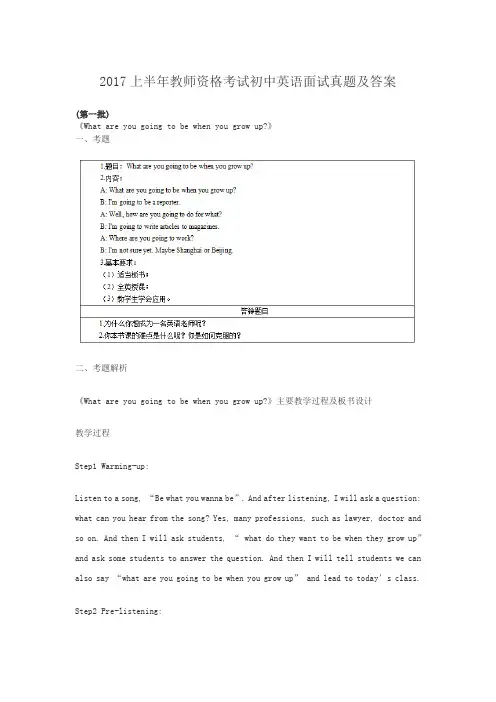
2017上半年教师资格考试初中英语面试真题及答案(第一批)《What are you going to be when you grow up?》一、考题二、考题解析《What are you going to be when you grow up?》主要教学过程及板书设计教学过程Step1 Warming-up:Listen to a song, “Be what you wanna be”. And after listening, I will ask a question: what can you hear from the song? Yes, many professions, such as lawyer, doctor and so on. And then I will ask students, “ what do they want to be when they grow up”and ask some students to answer the question. And then I will tell students we can also say “what are you going to be when you grow up” and lead to today’s class.Step2 Pre-listening:I will show some pictures on the PPT, the first picture is about reporter and the second picture is about the article. I will write down the two words on the blackboard and then I will ask the students to read after me.Step3 While-listening:I will ask students to listen to the radio for the first time and then match the sentence with the picture on the PPT. The first picture is about the reporter, the second picture is about writing magazines and the third picture is about Shanghai.Then I will ask students to listen to the radio for the second time and after listening, I will ask them to answer three questions on the blackboard, the first one is “What is he going to do when he grows up”, the second one is “how is he going to do for that” and the third one is “where is he going to work”.I will ask students to listen to the radio for the third time and they need to read after the radio. And then I will divide the students into two groups, group A acts as A, and group B acts as B, and read the passage.Step 4 Post-listeningWe will play a game called “hot potato”. When the music begins to play, students need to pass the flower. And when the music stops, the student who is holding the flower need to answer the question about “what is he going to do when he grows up, how is he going to do for that or where is he going to work”.And then we will have a group work, four students as a group and students need to make a survey about what is their group members going to be, how is he or she going to do for that and where is he going to work. Five minutes later, I will ask some groups to show their report.Step5 Summary and homeworkI will ask students to read the passage to summarize what we have learned today. After class, they need to search more information about the job they want to do.板书设计答辩题目解析1.为什么你想成为一名英语老师呢?【参考答案】因为我的妈妈是一名老师,她为学生奉献的精神深深感动了我。
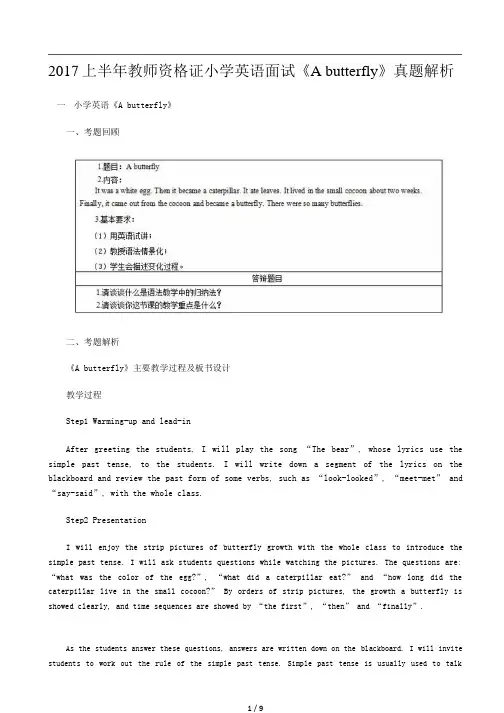
2017上半年教师资格证小学英语面试《A butterfly》真题解析一小学英语《A butterfly》一、考题回顾二、考题解析《A butterfly》主要教学过程及板书设计教学过程Step1 Warming-up and lead-inAfter greeting the students, I will play the song “The bear”, whose lyrics use the simple past tense, to the students. I will write down a segment of the lyrics on the blackboard and review the past form of some verbs, such as “look-looked”, “meet-met” and “say-said”, with the whole class.Step2 PresentationI will enjoy the strip pictures of butterfly growth with the whole class to introduce the simple past tense. I will ask students questions while watching the pictures. The questions are: “what was the color of the egg?”, “what did a caterpillar eat?” and “how long did the caterpillar live in t he small cocoon?” By orders of strip pictures, the growth a butterfly is showed clearly, and time sequences are showed by “the first”, “then” and “finally”.As the students answer these questions, answers are written down on the blackboard. I will invite students to work out the rule of the simple past tense. Simple past tense is usually used to talkabout a completed action or state that occurred in the past, and to form this tense, one needs to add -ed to the end of a regular verb and remember the past forms of some irregular verbs.Step3 Practice1. Conversion task: students are required to converse the following simple present tense into simple past tense to better understand the new structure:I usually eat an egg for breakfast.I _____ an egg for breakfast yesterday morning.People often live in houses.John _____ in the small village for about two years.Do you come to your grandma’s twice a week?He _____ to see his grandma last week.There are three people in my family.There _____ many butterflies here 5 years ago.2. Translation task: students are expected to translate the following Chinese intothe corresponding English.我妹妹早餐吃了一个橙子和一片面包。
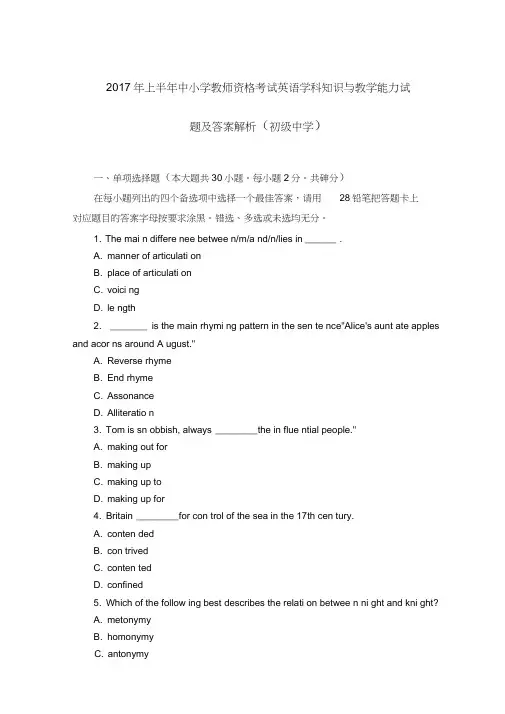
2017年上半年中小学教师资格考试英语学科知识与教学能力试题及答案解析(初级中学)一、单项选择题(本大题共30小题。
每小题2分。
共砷分)在每小题列出的四个备选项中选择一个最佳答案,请用28铅笔把答题卡上对应题目的答案字母按要求涂黑。
错选、多选或未选均无分。
1. The mai n differe nee betwee n/m/a nd/n/lies in ______ .A. manner of articulati onB. place of articulati onC. voici ngD. le ngth2. _______ is the main rhymi ng pattern in the sen te nce"Alice's aunt ate apples and acor ns around A ugust."A. Reverse rhymeB. End rhymeC. AssonanceD. Alliteratio n3. Tom is sn obbish, always ________ t he in flue ntial people."A. making out forB. making upC. making up toD. making up for4. Britain ________ f or con trol of the sea in the 17th cen tury.A. conten dedB. con trivedC. conten tedD. confined5. Which of the follow ing best describes the relati on betwee n ni ght and kni ght?A. metonymyB. homonymyC. antonymyD. hyp onymy6. Of the people who work here, _________ a re French and _________ En glish.A. half... halfB. the half... the halfC. a half... a halfD. a half... the half7. You'll find yourself thi nking about no thi ng ______ when you're veryn ervous.A. whereverB. whatsoeverC. wheneverD. however8. Mr. Joh nson has a habit of ask ing questi ons_______ .A. and the n not liste n to the an swersB. but the n no t liste n for the an swersC. and the n not liste ning to the an swersD. and the n does n't liste n to the an swers9. On hearing the utterance "It's hot here", the listener opened the door. It is a(n)A. locuti onary actB. illocutio nary actC. direct speech actD. perlocutio nary act10. What rhetoric device is used in the sentence "Many hands make light work"?A. Synecdoche.B. Simile.C. Metaphor.D. Oxym oron.11. When the teacher attempts to elicit more information from the students by saying "And ...?","Good. A nything else ?", etc, he/she is playing the role ofa _________ .A. prompterB. participa ntC. man agerD. con sulta nt12. For more advaneed learners, group work may be more appropriate than pair work for tasks that are __________ .A. li nguistically simpleB. structurally con trolledC. cog nitively challe ngingD. thematically non-dema nding13. When you focus on "uttera nee function" and "expected resp on se" by using examples like"Here you are ", "Tha nks", you are probably teach ing Ian guage at the .A. lexical levelB. sentence levelC. grammatical levelD. discourse level14. Which of the following tasks fails to encourage active Ianguage use?A. Recit ing a text.B. Barga ining in a shop,C. Writing an application letter.D. Readi ng to get a message.15. A teacher may en courage stude nts to ________ whe n they come across new words in fast read ing.A. take no tesB. ask for helpC. guess meaning from con textD. look up the words in a dicti onary16. Which of the followi ng stateme nts about task desig n is in correct?A. Activities must have clear and atta in able objectives.B. Activities should be confined to the classroom con text.C. Activities must be releva nt to stude nts' life experie nces.D. Activities should help develop stude nts' la nguage ability.17. If some one says "I know the word", he should not only un dersta nd its meaning but also be able to pronoun ce, spell, and ________ it.A. expla inB. recog nizeC. memorizeD. use18. Teachers could en courage stude nts to use ________ to gather and orga nize their ideas for writi ng.A. elicit ingB. mind mapp ingC. expla iningD. brai nstormi ng19. When stude nts are asked to go to the local museum, libraries, etc. to find out in formati on about endan gered ani mals and work out a pla n for an exhibiti on, they are doi ng a(n) ________ .A. surveyB. experime ntC. projectD. prese ntati on20. Which of the following tasks fails to develop students' skill of recognizing discourse patter ns?A. An alyz ing the structure of difficult senten ces.B. Check ing the logic of the author' s argume nts.C. Gett ing the scrambled senten ces into a paragraph.D. Marking out com mon ope ners to stories and jokes.请阅读Passage完成21-25小题。
![[职业资格类试卷]2017年上半年中学教师资格认定考试(初级英语学科知识与教学能力)真题试卷.doc](https://uimg.taocdn.com/96e2374367ec102de3bd8931.webp)
[职业资格类试卷]2017年上半年中学教师资格认定考试(初级英语学科知识与教学能力)真题试卷一、单项选择题1 The main difference between /m/ and /n/ lies in______.(A)manner of articulation(B)place of articulation(C)voicing(D)length2 _____ is the main rhyming pattern in the sentence "Alice's aunt ate apples and acorns around A ugust."(A)Reverse rhyme(B)End rhyme(C)Assonance(D)Alliteration3 Tom is snobbish, always______the influential people.(A)making out for(B)making up(C)making up to(D)making up for4 Britain______for control of the sea in the 17th century.(A)contended(B)contrived(C)contented(D)confined5 Which of the following best describes the relation between night and knight? (A)metonymy(B)homonymy(C)antonymy(D)hyponymy6 Of the people who work here,______are French and______ English.(A)half... half(B)the half... the half(C)a half... a half(D)a half... the half7 You'll find yourself thinking about nothing______when you' re very nervous. (A)wherever(B)whatsoever(C)whenever(D)however8 Mr. Johnson has a habit of asking questions______.(A)and then not listen to the answers(B)but then not listen for the answers(C)and then not listening to the answers(D)and then doesn' t listen to the answers9 On hearing the utterance "It's hot here ", the listener opened the door. It is a(n)______. (A)locutionary act(B)illocutionary act(C)direct speech act(D)perlocutionary act10 What rhetoric device is used in the sentence "Many hands make light work"?(A)Synecdoche.(B)Simile.(C)Metaphor.(D)Oxymoron.11 When the teacher attempts to elicit more information from the students by saying "And ...?",Good. Anything else?, etc, he/she is playing the role of a______.(A)prompter(B)participant(C)manager(D)consultant12 For more advanced learners, group work may be more appropriate than pair work for tasks that are______.(A)linguistically simple(B)structurally controlled(C)cognitively challenging(D)thematically non-demanding13 When you focus on "utterance function" and "expected response" by using examples like "Here you are", "Thanks", you are probably teaching language at the______.(A)lexical level(B)sentence level(C)grammatical level(D)discourse level14 Which of the following tasks fails to encourage active language use?(A)Reciting a text.(B)Bargaining in a shop.(C)Writing an application letter.(D)Reading to get a message.15 A teacher may encourage students to______when they come across new words in fast reading.(A)take notes(B)ask for help(C)guess meaning from context(D)look up the words in a dictionary16 Which of the following statements about task design is incorrect?(A)Activities must have clear and attainable objectives.(B)Activities should be confined to the classroom context.(C)Activities must be relevant to students' life experiences.(D)Activities should help develop students' language ability.17 If someone says "I know the word", he should not only understand its meaning but also be able to pronounce, spell, and______it.(A)explain(B)recognize(C)memorize(D)use18 Teachers could encourage students to use______to gather and organize their ideas for writing.(A)eliciting(B)mind mapping(C)explaining(D)brainstorming19 When students are asked to go to the local museum, libraries, etc. to find out information about endangered animals and work out a plan for an exhibition, they are doing a(n)______.(A)survey(B)experiment(C)project(D)presentation20 Which of the following tasks fails to develop students' skill of recognizing discourse patterns?(A)Analyzing the structure of difficult sentences.(B)Checking the logic of the author' s arguments.(C)Getting the scrambled sentences into a paragraph.(D)Marking out common openers to stories and jokes.二、简答题21 课后作业布置体现“差异性原则”。
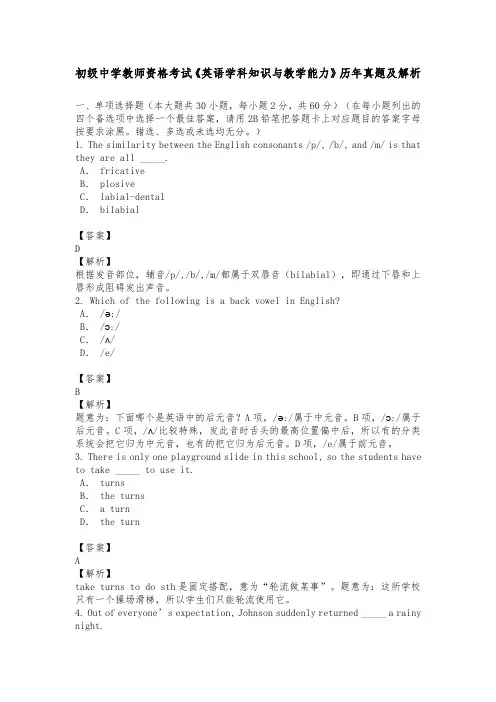
初级中学教师资格考试《英语学科知识与教学能力》历年真题及解析一、单项选择题(本大题共30小题,每小题2分,共60分)(在每小题列出的四个备选项中选择一个最佳答案,请用2B铅笔把答题卡上对应题目的答案字母按要求涂黑。
错选、多选或未选均无分。
)1.The similarity between the English consonants/p/,/b/,and/m/is that they are all_____.A.fricativeB.plosiveC.labial-dentalD.bilabial【答案】D【解析】根据发音部位,辅音/p/,/b/,/m/都属于双唇音(bilabial),即通过下唇和上唇形成阻碍发出声音。
2.Which of the following is a back vowel in English?A./ə:/B./ɔ:/C./ʌ/D./e/【答案】B【解析】题意为:下面哪个是英语中的后元音?A项,/ə:/属于中元音。
B项,/ɔ:/属于后元音。
C项,/ʌ/比较特殊,发此音时舌头的最高位置偏中后,所以有的分类系统会把它归为中元音,也有的把它归为后元音。
D项,/e/属于前元音。
3.There is only one playground slide in this school,so the students have to take_____to use it.A.turnsB.the turnsC.a turnD.the turn【答案】A【解析】take turns to do sth是固定搭配,意为“轮流做某事”。
题意为:这所学校只有一个操场滑梯,所以学生们只能轮流使用它。
4.Out of everyone’s expectation,Johnson suddenly returned_____a rainy night.A.atB.inC.onD.during【答案】C【解析】表示时间常用的介词有at,in,on,during等。
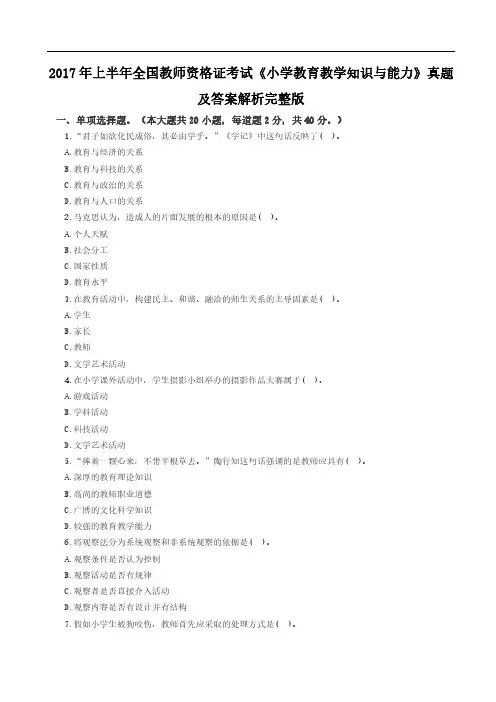
2017年上半年全国教师资格证考试《小学教育教学知识与能力》真题及答案解析完整版一、单项选择题。
(本大题共20小题,每道题2分,共40分。
)1.“君子如欲化民成俗,其必由学乎。
”《学记》中这句话反映了()。
A.教育与经济的关系B.教育与科技的关系C.教育与政治的关系D.教育与人口的关系2.马克思认为,造成人的片面发展的根本的原因是()。
A.个人天赋B.社会分工C.国家性质D.教育水平3.在教育活动中,构建民主、和谐、融洽的师生关系的主导因素是()。
A.学生B.家长C.教师D.文学艺术活动4.在小学课外活动中,学生摄影小组举办的摄影作品大赛属于()。
A.游戏活动B.学科活动C.科技活动D.文学艺术活动5.“捧着一颗心来,不带半根草去。
”陶行知这句话强调的是教师应具有()。
A.深厚的教育理论知识B.高尚的教师职业道德C.广博的文化科学知识D.较强的教育教学能力6.将观察法分为系统观察和非系统观察的依据是()。
A.观察条件是否认为控制B.观察活动是否有规律C.观察者是否直接介入活动D.观察内容是否有设计并有结构7.假如小学生被狗咬伤,教师首先应采取的处理方式是()。
A.立即包扎伤口B.在伤口的近心端用绳子扎紧C.用肥皂水、高锰酸钾溶液或双氧水等冲洗伤口D.不作处理,直接送往医院8.成成同学在回答问题时能触类旁通,不墨守成规,说明其思维具有()。
A.广阔性B.流畅性C.变通性D.独创性9.学生的学习是基于自己的经验,主动接受新的信息,并对其意义进行重构的过程,这一观点属于()。
A.有意义接受学习理论B.建构主义学习理论C.信息加工学习理论D.联传主义学习理论10.小强不按时完成作业,妈妈就禁止他看动画片,一旦按时完成就取消这一禁令,随后小强按时完成作业的次数增加了,这属于()。
A.正强化B.负强化C.自我强化D.替代强化11.根据皮亚杰的道德发展阶段理论,小学低年级儿童常常认为听父母和老师的话就是好孩子。
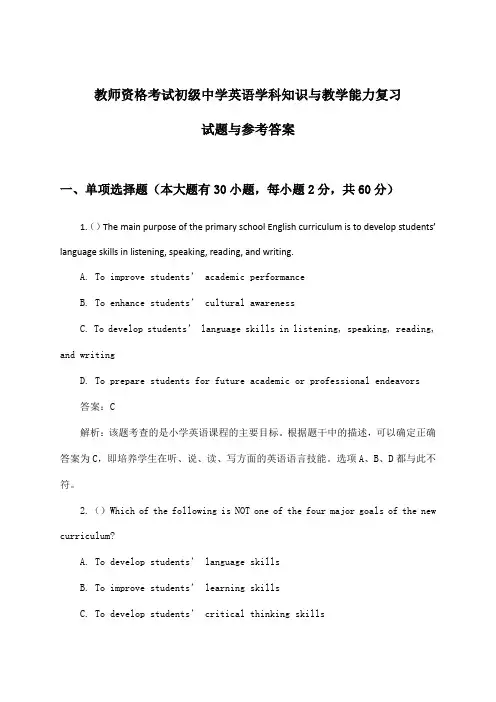
教师资格考试初级中学英语学科知识与教学能力复习试题与参考答案一、单项选择题(本大题有30小题,每小题2分,共60分)1.()The main purpose of the primary school English curriculum is to develop students’ language skills in listening, speaking, reading, and writing.A. To improve students’ academic performanceB. To enhance students’ cultural awarenessC. To develop students’ language skills in listening, speaking, reading, and writingD. To prepare students for future academic or professional endeavors答案:C解析:该题考查的是小学英语课程的主要目标。
根据题干中的描述,可以确定正确答案为C,即培养学生在听、说、读、写方面的英语语言技能。
选项A、B、D都与此不符。
2.()Which of the following is NOT one of the four major goals of the new curriculum?A. To develop students’ language skillsB. To improve students’ learning skillsC. To develop students’ critical thinking skillsD. To develop stud ents’ cultural awareness答案:D解析:该题询问新课程的四大目标中不包括哪一项。
根据对新课程标准的了解,可以知道其四大目标包括培养学生的语言技能、学习技能以及跨文化交际能力,而选项D 中的“培养学生文化意识”并不属于这四大目标之一。
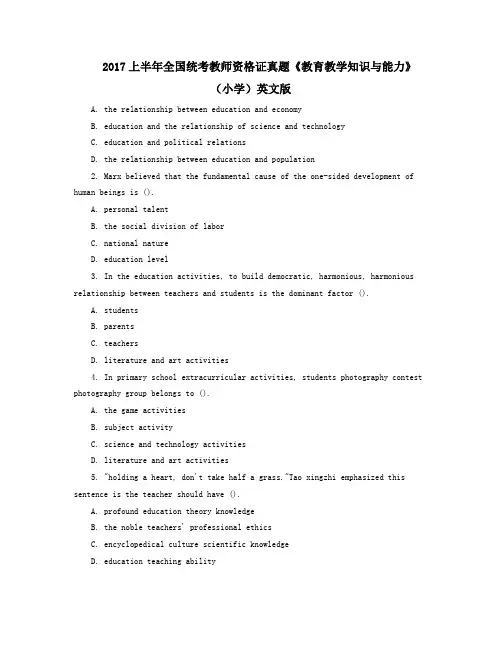
2017上半年全国统考教师资格证真题《教育教学知识与能力》(小学)英文版A. the relationship between education and economyB. education and the relationship of science and technologyC. education and political relationsD. the relationship between education and population2. Marx believed that the fundamental cause of the one-sided development of human beings is ().A. personal talentB. the social division of laborC. national natureD. education level3. In the education activities, to build democratic, harmonious, harmonious relationship between teachers and students is the dominant factor ().A. studentsB. parentsC. teachersD. literature and art activities4. In primary school extracurricular activities, students photography contest photography group belongs to ().A. the game activitiesB. subject activityC. science and technology activitiesD. literature and art activities5. "holding a heart, don't take half a grass."Tao xingzhi emphasized this sentence is the teacher should have ().A. profound education theory knowledgeB. the noble teachers' professional ethicsC. encyclopedical culture scientific knowledgeD. education teaching ability6. The observation method is divided into the basis of system observation and the observation is ().A. observe whether conditions thought controlB. to see whether it has regular activitiesC. the observer is directly involved in activitiesD. observe whether the content design and structure7. If pupils are bitten by the dog, the teacher first should take the way is ().A. the wound immediatelyB. close to the heart of the wound with a rope tied tightlyC. with soap and water, potassium permanganate and hydrogen peroxide rinse the woundD. do not make processing, directly to the hospital8 into a classmate in can answer in one instance, hidebound, explain the thinking is ().A. extensityB. fluencyC. flexibilityD. the originality9. Student learning is based on his own experience, take the initiative to accept new information, and the significance of refactoring process, this view belongs to ().A. meaningful reception learning theoryB. the constructivism learning theoryC. information processing and learning theoryD. the socialist learning theory10. Jack Bauer doesn't finish the homework, mother will forbid him watching cartoon, once finish will cancel this ban, then jack Bauer finish your homework on time the number of times increases, it belongs to ().A. positive reinforcementB. the negative reinforcementC. self-reinforcingD. replace reinforcement11. According to piaget's theory of moral development stage, the elementary school lower grade children often think that listen to your parents and teachersis good boy.This is because of its moral development in ().A. authority stageB. a fair stageC. reversible phaseD. self-centered stage12. "adhd children" are the core features of ().A. too many activitiesB. impulsiveC. attention disordersD. learning difficulties13. The course is organized education content.First suggested the idea is that ().A. spencerB. brunerC. hull bahtD. comenius,14. Schools use approved, window, corridors, walls, sculpture, ground, buildings and other media, designed to reflect education idea, the implementation and function.In the course classification, it belongs to ().A. discipline curriculumB. activity curriculumC. dominant curriculumD. invisible course15. Learn the "blind" one, students learn to "letter, lift, frogs, a" new English words, understand and memorize "endless.The world "and otherwords.According to the requirements of the 3 d object, this is mainly to achieve the teaching goal of ().A. knowledge and skillsB. process and methodsC. cognitive practiceD. emotional attitude and values16. Can let the student fully interactions play a role of the main body and is beneficial to teaching organization form is ().A. Dalton planB. individual teachingC. grouping teachingD. nutter card system17. In the classroom teaching, classroom chairs will affect the use of teaching method effect to put way.Generally speaking, "seedling bed" is the most suitable teaching method ().A. experimental methodB. the teaching methodC. inquiry methodD. to visit theory method18 teachers through the dictation English words, understand the students master the situation.This way of evaluation belongs to ().A. test evaluationB. scale evaluationC. implementation evaluationD. file cover19. The compulsory education mathematics curriculum standards (2011 edition) "regulation: the elementary school in the first period preliminary understanding and decimal fractions, the second to learn the meaning of the understanding fractions and decimals.This requires the part should be taken to organization ().A. linearB. circle typeC. a spiralD. horizontal type20. A teacher in the classroom to show a clock model, through to the operation of the three hands, help students quickly understand the concept of "the hours, minutes and seconds", it embodies the teaching principle of ().A. consolidation principleB. visual principleC. principle of step by stepD. their aptitude principleEach item (item 3 in this topic, 10 points, a total of 30 points)21. A brief introduction of Gardner's theory of multiple intelligences.22. The brief subjective initiative role in individual development.23. The paper head teacher understanding, the main content of research students.24. Material:In a primary school new teachers orientation, surrounding the "what kind of teacher is a real good teacher?"This problem, everyone open debate.Some said: "a good teacher is the love student teacher";Some said: "a good teacher should be a teacher by worthy example";And say: "good teaching is a good teacher"...At this time, training teachers to share with you the story of a writer: "when I was a child, I was very shy, never active hands class, the teacher never told me to answer this question, once, I wrote an article entitled" every leaf has a soul "composition, in the class, the teacher gently footpath in front of me, asked me whether I would like to share with you my composition.Her culture is so soft and warm, let me can't refuse.I have finished the composition, with the voice of fibrillation shaking, she thanked me.The class was over, when I went to the door of the classroom, she suggested that I get into the habit of keeping a diary, also can be engaged in this aspect of the work in the future.I did all that."This story caused people to "good teacher" deeper thinking.Question:1. The combination of materials, test analysis "what kind of teacher is a good teacher?"(10)2. Try to say primary school teachers how to provide appropriate education for children's development.(10)25. Material:Language teacher in teaching classical poetry "chunxiao", little dragon could not help but ask: "teacher, poet spring good sleeping, don't even know thatmorning, he how can hear the sound of the night?"Teachers without thinking, said: "this have what strange, the morning get up outside a look not to know."Little dragon also wanted to ask, the teacher gave a impatiently, let him sit down, and said: "everyone in class to listen earnestly, don't ask questions."Classroom immediately quiet down, little dragon also looked down in embarrassment.(1) combined with material and analyzes the practice of the teachers deal with students classroom questioning.(10)(2) talk about teachers how to protect and develop the students' question consciousness.(10)(a total of 6 item, this big question answer (choose 1 item, more than a score according to item 1 and only 40 minutes.Candidates can according to the specialty direction, select the answer.26 for Chinese language and society, 27 for math and science, English is the 28, 29 for music, 30 for the sports, 31 for the fine arts)26.Please complete the following tasks according to the above materials.(1) the brief analysis of the text characteristics of writing.(10)(2) the students learning guidance middle-aged period, try to formulate the teaching goal, teaching important and difficult.(10)(3) according to the proposed the teaching goal, teaching design of new import link indicating the design intent.(20 points)27Complete the following tasks according to the above material.(1) please list in mathematical statistics and probability "learning involves three statistical figure, analysis of the connection and difference between the three statistical figure.(10)(2) if the guidance of senior students to learn, to formulate the teaching goal.(10)(3) based on the proposed the teaching goal, the design of classroom teaching link, indicating the design intent.(20 points)28. (1) briefly describes the role of English children's songs in the teaching.(2) according to the given material, try to formulate the teaching goal.(3) according to the proposed the teaching goal, the design import andpractice link of teaching activities and explain the reasons.29. Please read the following materials and answer as required.Please according to the above materials to complete the following tasks:(1) the brief analysis of the characteristics of the songs (10 points)(2) to help other students learn songs just wait, try to formulate theteaching goal (10 points)(3) according to formulate the teaching goal, the combination of song learning, design "felt antiphonal singing characteristics in music practice activity" teaching, indicating the design reason.(20 points)30. Please read the following materials and answer as required.Action method: support foot at the front of the ball side, knees slightly bent, lean forward, knees, dribbling foot inside push the ball with their feet after the central forward, then dribble feet natural land.Please according to the above materials to complete the following tasks:(1) brief description "dribble" foot inside the emphases and difficulties of teaching.(10)(2) if the guidance level 2 students practice, try to formulate the teaching goal.(10)(3) the basis to formulate the teaching goal, teaching design technology steps indicating the design reason.(20 points)31. Please read the following materials and answer as required.(1) what is the print?Print by color classified roughly that several?(2) how to middle school period refers to the primary school students learnthis lesson, try to formulate the teaching goal?(3) the basis to formulate the teaching goal, the import link and give reasons.(4) the basis to formulate the teaching goal, "study on seal engravingpainting method" the content of the new grant teaching activities and explain the reasons.。
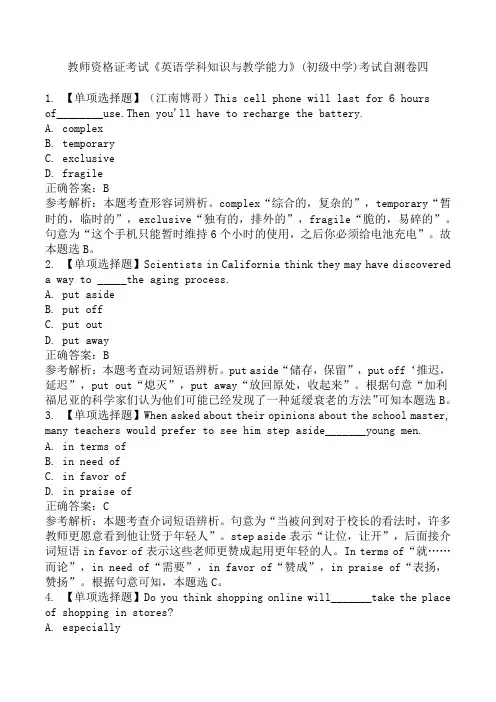
教师资格证考试《英语学科知识与教学能力》(初级中学)考试自测卷四1. 【单项选择题】(江南博哥)This cell phone will last for 6 hoursof________use.Then you'll have to recharge the battery.A. complexB. temporaryC. exclusiveD. fragile正确答案:B参考解析:本题考查形容词辨析。
complex“综合的,复杂的”,temporary“暂时的,临时的”,exclusive“独有的,排外的”,fragile“脆的,易碎的”。
句意为“这个手机只能暂时维持6个小时的使用,之后你必须给电池充电”。
故本题选B。
2. 【单项选择题】Scientists in California think they may have discovereda way to _____the aging process.A. put asideB. put offC. put outD. put away正确答案:B参考解析:本题考查动词短语辨析。
put aside“储存,保留”,put off‘推迟,延迟”,put out“熄灭”,put away“放回原处,收起来”。
根据句意“加利福尼亚的科学家们认为他们可能已经发现了一种延缓衰老的方法”可知本题选B。
3. 【单项选择题】When asked about their opinions about the school master, many teachers would prefer to see him step aside_______young men.A. in terms ofB. in need ofC. in favor ofD. in praise of正确答案:C参考解析:本题考查介词短语辨析。
句意为“当被问到对于校长的看法时,许多教师更愿意看到他让贤于年轻人”。
20XX上半年教师资格证面试真题及解析:初中英语(第一批)初中英语《What are you going to be when you grow up?〉、考题回顾二、考题解析《What are you going to be when you grow up?〉主要教学过程及板书设计矚慫润厲钐瘗睞枥庑赖。
矚慫润厲钐瘗睞枥庑赖賃。
教学过程Stepl Warmin g-up:Listen to a song, “Be what you wanna be ft e r. lAitieharg, I will ask aquestion: what can you hear from the song? Yes, many professions, such as lawyer, doctor and so on. And the n I will ask stude nts, “ what do they want to be whe n they grow up ” and ask some students to answer the question. An(ethl will tell students we can also say “what are you going to be when you grow up ” and lead to today class聞創沟燴鐺險爱氇谴净。
聞創沟燴鐺險爱氇谴净祸。
Step2 Pre-liste ning:I will show some pictures on the PPT, the first picture is about reporter and the sec ond picture is about the article. I will write dow n the two words on the blackboard and the n I will ask the stude nts to read after me 残骛楼諍锩瀨濟溆塹籟。
2017年上半年中小学教师资格考试英语学科知识与教学能力试题(初级中学)参考答案及解析一、单项选择题1.【答案】B。
解析:考查英语音素。
在发音方式上,二者都是鼻音;按照带声性,二者都带声,都是浊辅音;在发音部位上,/m/是双唇音,/n/是齿龈音。
故选B。
length指音的长度,是元音的特征。
2.【答案】D。
解析:考查押韵。
“Alice’s aunt ate apples and acorns around Aaugust.”该句中每一个单词都以a开头,英语中一组词、一句话或是一行诗中重复出现开头音相同的词,这种修辞手法称为押头韵,主要包括词首元音的重复、词首辅音的重复和辅音连缀的重复三种形式。
押头韵在英语里叫alliteration,又叫initial rhyme或head rhyme,如first and foremost,Becky’s beagle barked and hayed,becoming bothersome for Billy.故选D。
reserve rhyme是反韵,end rhyme是尾韵,assonance 是类韵/半谐音。
3.【答案】C。
解析:考查动词短语辨析。
句意为“汤姆很势利,经常____有影响力的人”。
make sth.out“理解,辨认”,make up“编造,整理,化妆,弥补,和解”;make up to“巴结,奉承,讨好”;make up for“补偿,弥补”。
根据句意可知C项正确。
4.【答案】A。
解析:考查动词辨析。
句意为“英国在17世纪____海上控制权”。
Contend“竞争,争夺”,常与for连用,意为“为……而竞争”;contrive“设计,发明,谋划”;content“使满足;使满意”,常与with连用;confine常与to连用,表示“限制于,局限于”。
根据句意可知A项正确。
5.【答案】B。
解析:考查语义学。
Night“夜晚”,knight“骑士”,两词发音相同,但拼写和意义不同,因此属于同音异义词。
2017初中英语教师资格证《知识与教学能力》考试试题【- 教师资格考试试题及答案】正在为初中英语教师资格证考试做准备的考生们,小编为你整理了“2017初中英语教师资格证《知识与教学能力》考试试题”,为各位考生提供备考资料,内容含金量高,详情请关注小编。
2017初中英语教师资格证《知识与教学能力》考试试题一、单项选择题(本大题共30小题,每小题2分,共60分)1.China is planning to build__________new station in __________ South Pole for scientific research in 5—1 5 year's time.A.the;theB.a;theC.the;不填D.a;不填2.Generally speaking.the air pollution in cities is more serious than__________in the country.A.onesB.oneC.thatD.those3.It’S surprising that this innocent—looking person should have__________such a crime.A.performedB.madeC.actedDmitted4.一Which Of the two ties would you like to wear?__________.You know I'm not particular about ties.A.AnyB.EitherC.BothD.Neither。
2017年上半年教师资格统考《英语学科(初中)》试题一、单选题(本大题共20小题,每小题2分,共40分在每小题列出的四个备选项中选择一个最佳答案,请用2B铅笔把答题卡上对应题目的答案字母按要求涂黑。
错选、多选或未选均无分。
)1.The main difference between/m/and/n/lies in_____.A.manner of articulationB.place of articulationC.voicingD.length2._____is the main rhyming pattern in the sentence"Alice's aunt ate apples and acorns around August."A.Reverse rhymeB.End rhymeC.AssonanceD.Alliteration3.Tom is snobbish,always_____the influential people.A.making out forB.making upC.making up toD.making up for4.Britin_____for control of the sea in the17th Century.A.contendedB.contrivedC.contentedD.confined5.Which of the following best describes the relation between night and knight?A.metonymyB.homonymyC.antonymyD.hyponymy6.Of the people who work here,_____are French and_____English.A.half…halfB.the half…the halfC.a half…a halfD.a half…the half7.You'll find yourself thinking about nothing_____whofen you are very nervous.A.whereverB.whatsoeverC.wheneverD.however8.Mr.Johnson has a habit of asking question_____.A.and then not listen to the answersB.but then not listen for the answersC.and then not listening to the answersD.and then doesn't listen to the answers9.On hearing the utterance"It's hot here",the listener open the door.It is a (n)_____.A.locutionary actB.illocutionary actC.direct speech actD.perlocutionary act10.What rhetoric device is used in the sentence"many hands make light work"?A.SynecdocheB.SimileC.MetaphorD.Oxymoron11.When the teacher attempts to elicit more information from the students by saying "And…?","Good.Anything else?",etc,he/she is playing the role of a_____.A.prompterB.participantC.managerD.consultant12.For more advanced learners,group work may be more appropriate than pair work for tasks that are_____.A.linguistically simpleB.structurally controlledC.cognitively challengingD.thematically non-demanding13.When you focus on"utterance function"and"expected response"by using examples like"Here you are","Thanks",you are probably teaching language at the_____.A.lexical levelB.sentence levelC.grammatical levelD.discourse level14.Which of the following tasks fails to encourage active language use?A.Reciting a textB.Bargaining in a shopC.Writing an application letterD.Reading to get message15.A teacher may encourage students to_____when they come across new words in fast reading.A.take notesB.ask for helpC.guess meaning from contextD.look up the words in a dictionary16.Which of the following statements about task design is incorrect?A.Activities must have clear and attainable objectivesB.Activities should be confined to the classroom contextC.Activities must be relevant to student's life experiencesD.Activities should help develop students'language ability.17.If someone says"I know the word",he should not only understand its meaning but also be able to pronounce,spell,and_____it.A.explainB.recognizeC.memorizee18.Teachers could encourage students to use_____to gather and organize their ideas for writing.A.elicitingB.mind mappingC.explainingD.brainstorming19.When students are asked to go to the local museum,libraries,etc.to find out information about endangered animals and work out a plan for an exhibition,they are doing a(n)_____.A.surveyB.experimentC.projectD.presentation20.Which of the following tasks fails to develop students'skill of recognizing discourse patterns?A.Analyzing the student of difficult sentencesB.Checking the logic of the author's argumentsC.Getting the scrambled sentences into a paragraphD.Marking out common openers to stories and jokes.请阅读Passage1,完成21~25小题。
2016年上半年中小学教师资格考试真题试卷"英语学科知识与教学能力"〔初级中学〕〔总分值150分〕一、单项选择题〔本大题共30小题,每题2分,共60分〕1. Walnut trees____environment stresses such as drought by producing significantamounts of a substance similar to aspirin.A. turn toB. confirm toC. contribute toD. respond to2. John felt great____about his uping trip to Sidney;indeed,he could hardlycontain his enthusiasm.A. unrestB. uncertaintyC. anxietyD. excitement3. The professor’s classroom manner was quite____, never revealing the warmth and playfulness she showed in private.A. livelyB. amiableC. formalD. cheerful4. Again as____in this experiment, he didn’t lose heart.A. he failedB. did he failC. he did failD. had he failed5. Taiwan lies____the east of Fujian and is larger than____island in China.A. to;anyB. in;anyC.to;any otherD. in;any other6. Johnson is a man of great experience,____much can be learned.A. for whomB. for whichC. from thatD. from whom7. Which of the following shows the correct sentence stress in normal cases"A. His ʹbrother is my ʹbest friend.B. They ʹhelp one ʹanother in their work.C. They have ʹbeen in the ʹcountryside recently.D. She ʹthought herself ʹbetter ʹthan ʹanyone else.8. The phrase“____〞exemplifies the inplete plosionat the junction of words.A. good morningB. black shirtC. delicious cherryD. beautiful jacket9. The synonymous pair “____〞differ in degree of formality.A. pass away and pop offB. accuse and chargeC. prison and jailD. tap and faucet10. When using the imperati ve “Turn it off〞to give an order, the speaker highlights the____of the utterance.A. locutionary actB. illocutionary actC. perlocutionary actD. indirect speech act11. Fluent and appropriate language use requires knowledge of____and this suggeststhat we should teach lexical chunks rather than single words.A. connotationB. denotationC. morphologyD. collocation12.“Underlining all the past form verbsin the dialogue〞is a typical exercise focusing on ____.A. useB. formC. meaningD. function13. Which of the following activities may be more appropriate to help students practice a newstructure immediately after presentation in class"A. Roleplay.B. Group discussion.C. Pattern drill.D. Written homework.14. When teaching students how to give appropriate responses to a congratulation or an apology,the teacher is probably teaching at____.A. lexical levelB. sentence levelC. grammatical levelD. discourse level15. Which of the following activities can help develop the skill of listening for gist"A. Listen and find out where Jim lives.B. Listen and decide on the best title for the passage.C. Listen and underline the words the speaker stresses.D.Listen to pairs of words and tell if they are the same.16. When an EFL teacher asks his students“How do you know that the author liked the placesince he did not tell us explicitly"〞, he/she is helping students to reach____prehension.A. literalB. evaluativeC. inferentialD. appreciative17. Which of the following types of questions are mostly used for checking literal prehensionof the text"A. Display questions.B. Rhetoricalquestions.C. Evaluation questions.D. Referential questions.18. Which of the following is a typical feature of informal writing"A. A well-organized structure is preferred.B. Short and inplete sentences are mon.C. Technical terms and definitions are required.D. A wide range of vocabulary and structural patterns are used.19. Peer-editing during class is an important step of the____approach to teaching.A. genre-basedB. content-basedC. process-orientedD. product-oriented20. Portfolios, daily reports and speech delivering are typical means of ____.A. norm-referenced testB. criterion-referenced testC. summative assessmentD. formative assessment阅读Passage 1,完成第21~25小题。
教师资格考试初级中学英语学科知识与教学能力复习试卷与参考答案一、单项选择题(本大题有30小题,每小题2分,共60分)1.数字、下列哪个选项不是英语语音的音标?A. /p/B. /t/C. /k/D. /m/答案:D解析:英语语音的音标包括元音和辅音。
元音有5个:/i/, /ɪ/, /u/, /ʊ/, /ə/;辅音有21个,其中包括/p/, /t/, /k/, /m/等。
因此,选项D不是英语语音的音标。
2.数字、下列哪个选项是英语中的连词?A. !B. ?C. ;D. :答案:C解析:英语中的连词有多种,包括并列连词(如and, or, but)、从属连词(如because, if, while)等。
选项C中的分号(;)在句子中起到连接作用,表示两个独立句子之间的关系,因此是连词。
其他选项并非连词。
3、The concept of “tea and milk order” in English teaching refers to which one of the following?A)The order in which students present their ideas during a group discussion.B)The rule for students to follow when ordering tea in a British cafe.C)The sequence of completing tasks in a structured teaching lesson plan.D)The practice of teaching students foreign language customs in relationto daily routines.Answer: CExplanation: The “tea and milk order” concept in English teaching pertains to the structure and sequence of activities in a lesson plan. It is often used as a metaphor to help students understand the logical order in which an English lesson, or any lesson, is taught. This concept emphasizes the importance of a structured approach to learning and teaching, ensuring that material is presented in a coherent and logical order.4、Which of the following is a common form of classroom management technique used to maintain order and focus among students?A)Verbal persuasionB)Setting classroom expectationsC)Using positive reinforcementD)All of the aboveAnswer: DExplanation: All of the options listed are strategies for classroommanagement. Verbal persuasion involves talking to students to persuade them to comply with class rules. Setting classroom expectations helps students know what to expect from you and what you expect from them, which can lead to better behavior and participation. Using positive reinforcement encourages desired behaviors by providing rewards, which can also contribute to a more orderly and focused classroom environment. Therefore, all options represent effective techniques for managing the classroom.5、Which of the following is NOT a feature of communicative language teaching?A. Emphasis on fluency and accuracyB. Focus on teacher-centered activitiesC. Use of authentic materialsD. Student-centered learningAnswer: B解析: Communicative language teaching emphasizes student-centered learning, authentic materials, and fluency and accuracy. Traditional, teacher-centered activities are not a core feature.6、A teacher wants to help her students learn the meaning of new vocabulary while promoting their collaborative learning skills. Which of the following activities would be most effective?A. Providing students with a list of new words and their definitions.B. Having students work in pairs to act out scenarios using the new words.C. Dictating a paragraph containing the new words and asking students to copy it down.D. Giving students a worksheet with fill-in-the-blank exercises using the new words.Answer: B解析: Acting out scenarios encourages students to use the new vocabulary in context, promotes collaboration, and aids in comprehension and retention.7.When teaching a listening activity where students are to identify the presence of different consonants in several words, which of the following questions should the teacher utilize to increase student engagement?A. What are the words that means?B. Is there any word that contains the letter ‘p’?C. Can you write down the words on your activity sheet?D. Which of these words is longer than the others?Answer: BKey Explanation: The question “Is there any word that contains the letter ‘p’?” is designed to encourage students to pay attention to detail and enhance their listening skills. By prompting students to pinpoint the presence of the letter ‘p’, it directs their focus on a specific sound in the words, which is the educational objective of the listening activity.8.When using a video in an English language arts lesson, which of the following steps should a teacher take to ensure the video effectively supportslearning objectives?A. Show the video in its original language with subtitles.B. Have students record notes about the plot before and/or after viewing the video.C. Discussed the lessons learned while viewing the video immediately in English.D. Play the video at a fast pace to cover more content in a shorter time.Answer: BKey Explanation: By having students record notes about the plot before and/or after watching the video, the teacher can assess their comprehension and memory. This method is crucial in promoting active listening and fostering an analytical understanding of the video content. Additionally, comparing the notes before and after the video can help in building comprehension, encourage discussion, and allow the teacher to identify areas of difficulty.9、Which of the following is a suitable teaching method for teaching English listening skills to junior middle school students?• A. Through stories and dialogues.• B. Through grammar exercises and textbooks.• C. Through written texts and exams only.• D. Through music and videos only.答案:A解析:对于初中阶段的英语教学,特别是听力技能的教学,通过故事和对话进行是一种有效的教学方法,能够提高学生的听力理解和口语表达能力。
矿产资源开发利用方案编写内容要求及审查大纲
矿产资源开发利用方案编写内容要求及《矿产资源开发利用方案》审查大纲一、概述
㈠矿区位置、隶属关系和企业性质。
如为改扩建矿山, 应说明矿山现状、
特点及存在的主要问题。
㈡编制依据
(1简述项目前期工作进展情况及与有关方面对项目的意向性协议情况。
(2 列出开发利用方案编制所依据的主要基础性资料的名称。
如经储量管理部门认定的矿区地质勘探报告、选矿试验报告、加工利用试验报告、工程地质初评资料、矿区水文资料和供水资料等。
对改、扩建矿山应有生产实际资料, 如矿山总平面现状图、矿床开拓系统图、采场现状图和主要采选设备清单等。
二、矿产品需求现状和预测
㈠该矿产在国内需求情况和市场供应情况
1、矿产品现状及加工利用趋向。
2、国内近、远期的需求量及主要销向预测。
㈡产品价格分析
1、国内矿产品价格现状。
2、矿产品价格稳定性及变化趋势。
三、矿产资源概况
㈠矿区总体概况
1、矿区总体规划情况。
2、矿区矿产资源概况。
3、该设计与矿区总体开发的关系。
㈡该设计项目的资源概况
1、矿床地质及构造特征。
2、矿床开采技术条件及水文地质条件。